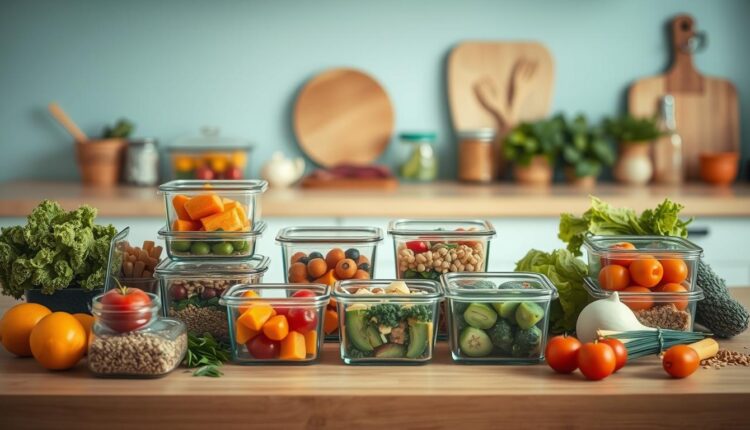Meal Prep For Work Clean Eating Without Processed Foods
Discover the ultimate guide to meal prep for work clean eating. Learn simple, practical strategies for healthy, no-stress meals without processed foods.
Between back-to-back meetings and school pickups, many of us default to whatever’s fastest—even if it leaves us sluggish by 3 PM. But what if nourishing yourself well didn’t require extra time or complicated recipes?
I’ve spent years refining systems that make wholesome eating effortless for busy schedules. The secret? Planning ahead with whole, minimally processed ingredients. Think roasted veggies waiting in your fridge or protein-packed grains ready to toss into salads. These aren’t Instagram-perfect containers—they’re real-life solutions for energy that lasts.
This guide shares my tested strategies for creating satisfying midday fuel. You’ll discover:
- How batch cooking transforms hectic weeks into no-stress routines
- Smart ways to build flavor without relying on packaged shortcuts
We’ll focus on practical steps, like prepping versatile bases (quinoa, roasted sweet potatoes) that morph into multiple meals. Because when you start with nutritious ingredients, even simple combinations taste vibrant.
Clean Eating Meal Prep
When I first heard the term “clean eating” a decade ago, it felt like another fleeting diet trend. Today, over 60% of U.S. professionals prioritize whole foods over packaged items, according to recent surveys. This shift isn’t about perfection—it’s about reclaiming control over what fuels our bodies during hectic days.
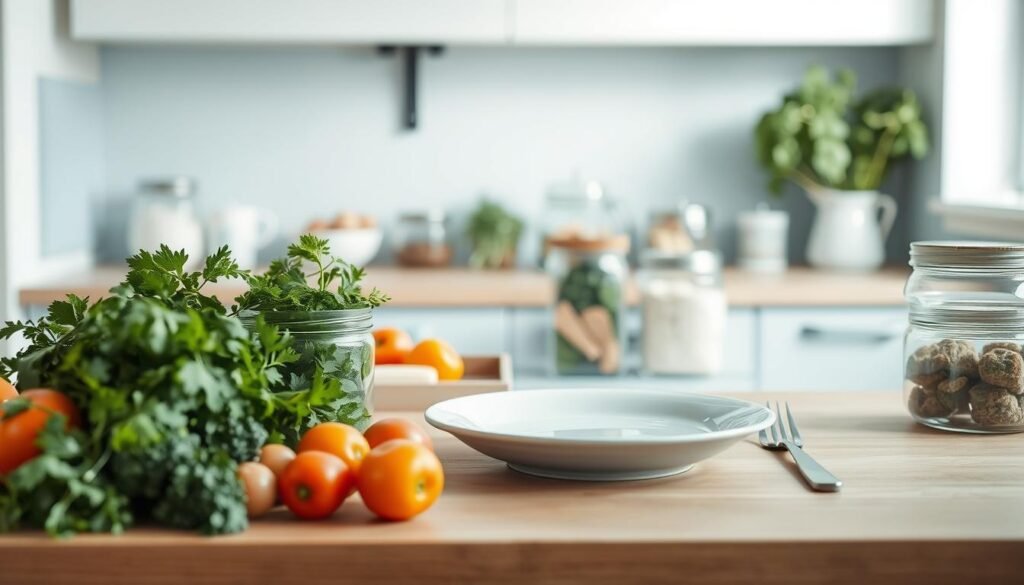
The Rising Trend of Whole-Food Focus
Clean eating emphasizes fresh ingredients in their simplest form—think crisp veggies, hearty grains, and unprocessed proteins. Social media platforms report a 142% increase in posts tagged #Cleaneating since 2020, reflecting growing interest in sustainable nutrition habits.
| Traditional Diets | Clean Eating Approach |
|---|---|
| Relies on frozen meals | Uses fresh seasonal produce |
| High sodium sauces | Herb-based flavor boosts |
| Quick sugar fixes | Energy-sustaining snacks |
Smart Strategies for Time-Crunched Schedules
Batch cooking transforms kitchen time into freedom. By preparing versatile bases like quinoa or roasted sweet potatoes on Sundays, you create building blocks for salads, stir-fries, or healthy meal prep recipes all week. One corporate trainer client told me: “Overnight oats became my breakfast armor against morning chaos.”
Successful systems thrive on simplicity. Whip up mason jar salads while dinner roasts cook. Blend chia puddings during conference calls. These small acts compound into big wins—less decision fatigue, more nourishing choices.
Understanding Clean Eating and Work Meal Prep Basics
Ever notice how a greasy takeout lunch leaves you foggy by 2 PM? That’s your body begging for real fuel. Whole-food nutrition isn’t about rigid rules—it’s choosing ingredients that nourish without hidden additives. Think vibrant vegetables, unprocessed proteins, and grains that haven’t been stripped of their goodness.
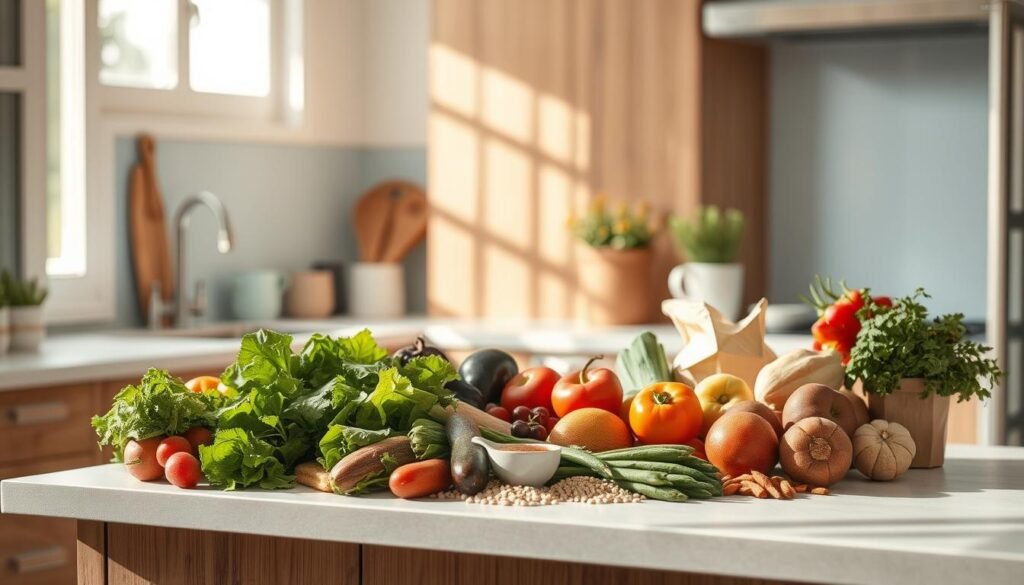
Nutritional Benefits of Whole Foods
Unprocessed ingredients deliver sustained energy because they’re packed with fiber and nutrients. A client once told me, “Swapping sugary snacks for almonds and berries changed my afternoon slump into steady focus.” That’s the power of nutrient density—food working for you, not against.
| Traditional Snacks | Whole-Food Swaps |
|---|---|
| Flavored yogurt (18g sugar) | Greek yogurt + fresh fruit |
| Microwave soup (high sodium) | Homemade veggie soup |
| Granola bars | Trail mix with nuts/seeds |
Lean proteins like grilled chicken or lentils keep you full longer. Pair them with roasted veggies or quinoa for balanced lunch bowls. Hearty soups loaded with beans and greens? They’re your secret weapon against 3 PM hunger pangs.
Plan ahead: batch-cook staples on Sundays. Portion Greek yogurt into jars with chia seeds for grab-and-go breakfasts. Roast a tray of sweet potatoes to toss into salads all week. These choices stabilize energy, so you conquer your day without crashing.
Remember, progress beats perfection. Start with one whole-food swap this week—your body will thank you by Friday.
Meal Prep for Work Clean Eating: Essential Strategies
Juggling deadlines and family dinners often leaves little room for kitchen experiments. The key to success? Start small. I learned this after burning through three batches of overcooked quinoa trying to “master” Sunday prep sessions. Now, I coach clients to focus on progress—not Pinterest perfection.
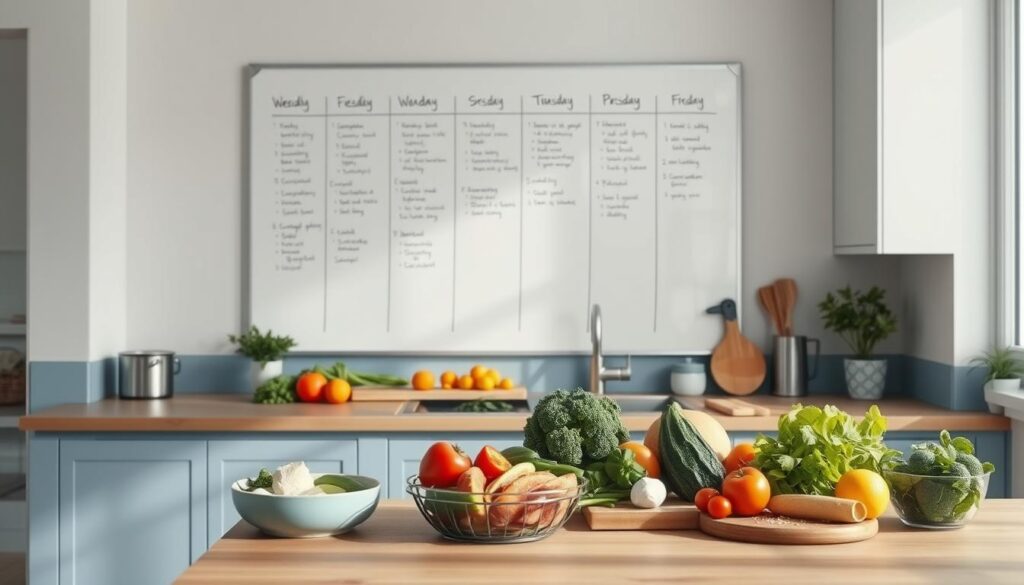
Setting Realistic Goals
Begin with two days of prepped dishes instead of five. One teacher I worked with started by roasting a single tray of veggies each Sunday. By Thursday, she’d transformed them into stir-fries and bowls topped with grilled chicken. Small wins build confidence—and sustainable habits.
Customizing Your Plan
Map your week around non-negotiables: meetings, gym time, or kids’ activities. Block 90 minutes for cooking (while listening to podcasts!) and 10 minutes nightly for assembly. Try this approach:
- Monday/Wednesday: Reheat pre-cooked grains + roasted veggies
- Tuesday/Thursday: Assemble salads with leftover proteins
- Friday: Use frozen soup portions from earlier batches
Boost fiber by swapping white rice for farro or barley. Need heat? Add spicy lunch ideas like chili-lime dressing. Track progress on a whiteboard—seeing “3 prepped days ✅” builds momentum.
Remember: Your plan should bend to your life, not break it. Store extra portions in freezer-safe containers for chaotic weeks. Consistency beats complexity every time.
Planning Balanced Meals Without Processed Foods
Ever stared at your fridge at 7 PM wondering how to assemble something satisfying from random ingredients? The magic lies in designing menus that flex with your schedule while keeping nutrition front-and-center. I learned this after serving my family salmon bowls three nights straight—until my teenager groaned, “Mom, we’re not bears at a fish hatchery!”
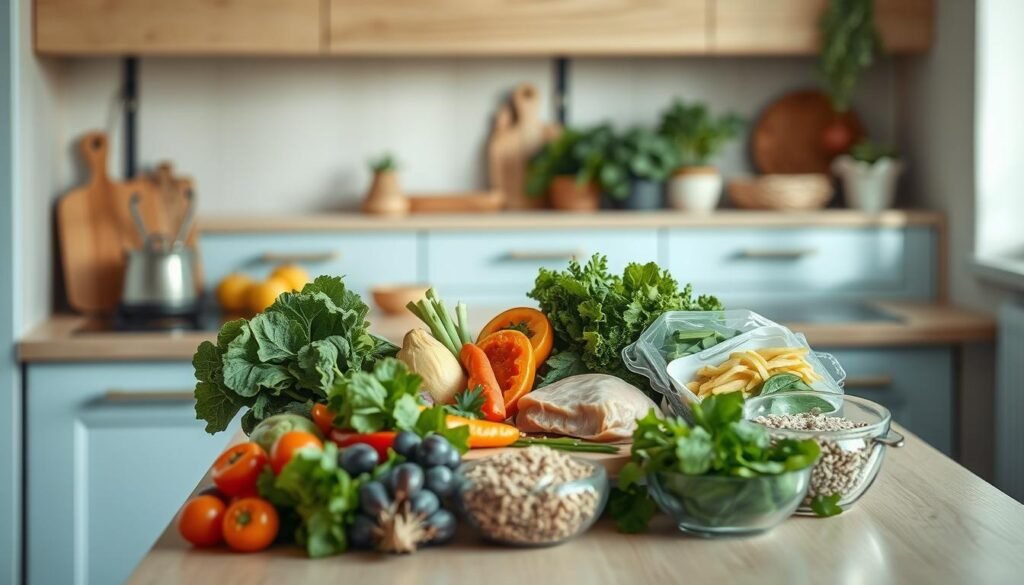
Creating Versatile Menus
Start with a base ingredient that plays multiple roles. Quinoa becomes Wednesday night’s bowl topping, Thursday’s soup thickener, and Friday night taco filler. This table shows how simple swaps create endless options:
| Base Dish | Flavor Boosters |
|---|---|
| Grilled chicken | Lemon zest + rosemary |
| Roasted veggies | Turmeric + smoked paprika |
| Mixed greens | Toasted seeds + citrus vinaigrette |
Leafy greens like kale or spinach work overtime. Toss them into scrambles, blend into pesto, or layer under proteins. Avocado adds creaminess to dressings without mayo—mash one with lime for instant sandwich spread.
Incorporating Fresh Produce and Lean Proteins
Build meals around seasonal colors. A client recently shared her “rainbow rule”: each plate needs three hues from fresh veggies. Pair roasted red peppers (vitamin C) with seared tuna (omega-3s) and sautéed zucchini (fiber).
Batch-cook proteins on Sundays for busy days. Try these combos:
- Shredded chicken + broccoli → stir-fry or wrap filling
- Black beans + sweet potato → tacos or grain bowl base
Swap avocado for cheese in salads to boost healthy fats. Keep chopped greens pre-washed for last-minute upgrades. When you plan three days of dinners using overlapping ingredients, days feel less chaotic—and more like a fun kitchen experiment.
Easy Recipes and Meal Prep Ideas for All Meals
Mornings often feel like a race against the clock—keys misplaced, coffee spills, and that nagging question: “What’s for breakfast?” Let’s solve that with delicious, no-fuss options that fuel your day. These recipes turn chaotic mornings into calm starts while keeping lunch and dinner equally stress-free.
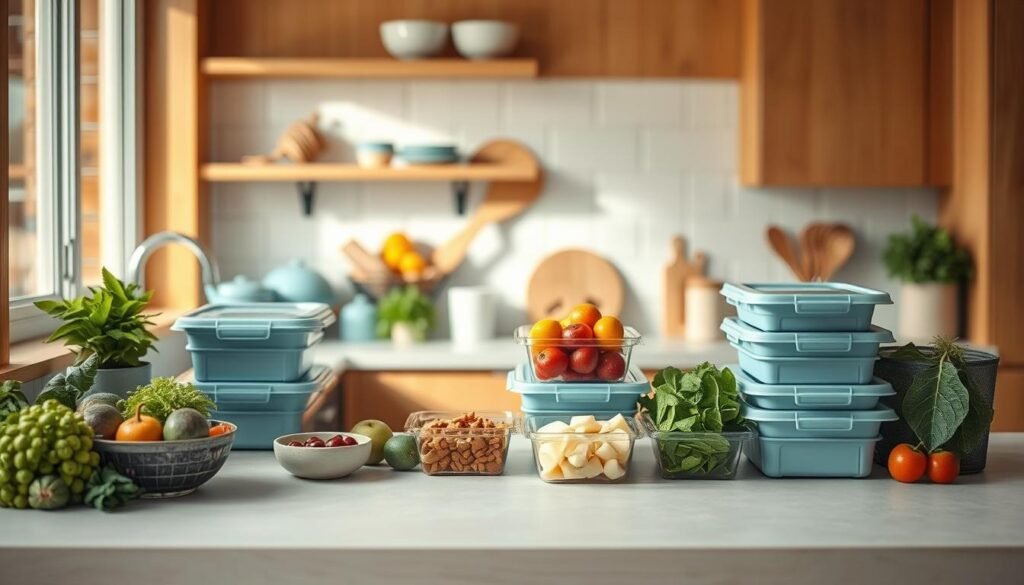
Breakfast: Quick & Nutritious Options
Whip up overnight oats while unloading the dishwasher. Layer rolled oats, almond milk, and chia seeds in jars—top with frozen berries before bed. A teacher client shared: “These kept me full through parent conferences without the 10 AM crash.”
- Spinach egg muffins: Blend 6 eggs + handful of greens, bake 20 mins
- Greek yogurt parfaits: Prep 3 jars with granola and sliced peaches
Lunch: Grab-and-Go Salads, Sandwiches, & Wraps
Build mason jar salads that stay crisp. Start with dressing at the bottom, add hearty ingredients like quinoa or chickpeas, then greens on top. This table shows winning combos:
| Base | Protein | Crunch Factor |
|---|---|---|
| Mixed greens | Grilled chicken | Toasted almonds |
| Farro | Black beans | Jicama sticks |
| Kale | Hard-boiled eggs | Sunflower seeds |
Wrap lovers: Spread hummus on collard leaves, add turkey slices and shredded carrots. Roll tightly—stays fresh 3 days.
Dinner: Comforting and Satisfying Recipes
After long days, nothing beats a warm bowl. My white bean chili cooks while you shower: sauté onions, add canned beans, broth, and cumin. Simmer 20 minutes. Top with avocado for creaminess.
Batch-roast vegetables Sunday night—toss with pasta or fold into omelets. Make plenty to cover 2-3 dinners. One parent told me: “Roasted cauliflower became taco filling AND soup garnish—total game-changer.”
Batch Cooking and Time-Saving Techniques
Ever open your fridge to find three identical containers of roasted broccoli staring back? Traditional batch cooking often leaves us stuck in a leftovers loop. That’s where meal prep light shines—a smarter approach focusing on flexible components rather than fully assembled dishes.

Meal Prep Light: Batch Cooking Explained
This method prioritizes strategic prep of proteins, veggies, and sauces in small quantities. Instead of cooking five chicken breasts, roast two with versatile seasonings. One corporate mom shared: “Prepping hard-boiled eggs and chopped veggies each Sunday lets me build egg salad wraps or grain bowls in 5 minutes.”
| Traditional Batch Cooking | Meal Prep Light |
|---|---|
| 5-day identical meals | 3 base ingredients |
| Large portions | Small-batch components |
| Limited flexibility | Mix-and-match options |
Kitchen Hacks for Efficiency
Maximize your time with these tested strategies:
- Roast veggies on sheet pans while proteins cook below (saves 20+ minutes)
- Blend sauces in reusable squeeze bottles for instant flavor boosts
- Store cauliflower rice in freezer bags—thaws perfectly for stir-fries
Transform leftovers creatively. Last night’s roasted peppers become today’s grain bowl topping or tomorrow’s omelet filling. A client recently raved: “Adding turmeric to roasted carrots made them work in both Mediterranean wraps and coconut curry.”
Keep components fresh by storing dressings separately. Use clear containers to spot ingredients quickly. With this system, you’ll spend less time cooking and more time enjoying vibrant dishes throughout the week.
Ingredient Spotlight: Whole Foods and Clean Staples
Navigating grocery aisles can feel overwhelming when you’re trying to eat well on a tight schedule. Let’s simplify by focusing on foundational ingredients that deliver maximum nutrition with minimal fuss. Stocking your kitchen with these staples turns last-minute scrambling into effortless assembly.
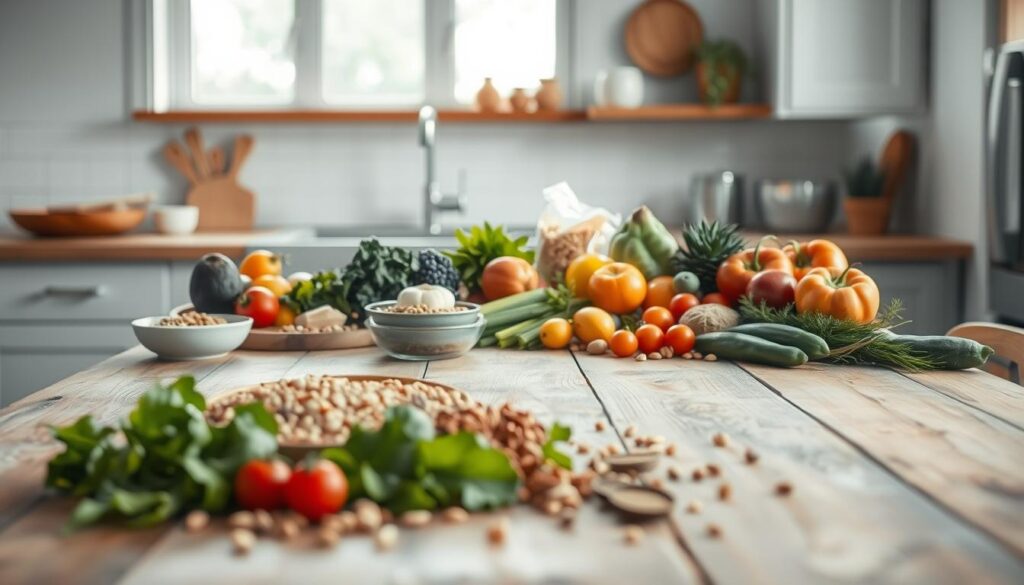
Maximizing Nutrient Density
Prioritize ingredients that pack a nutritional punch. White beans, for example, offer plant-based protein and fiber in just 15 minutes of prep time. Pair them with leafy greens like spinach (rich in iron) or roasted sweet potatoes (loaded with vitamin A) for balanced bowls.
| Ingredient | Key Nutrients | Prep Time |
|---|---|---|
| White beans | Fiber, protein | 15 mins |
| Kale | Vitamin K, calcium | 5 mins |
| Quinoa | Complete protein | 20 mins |
Batch-roast veggies while cooking grains to save time. A client recently shared: “Mixing roasted Brussels sprouts with farro and lemon dressing became my go-to lunch—ready in 10 minutes!”
Smart Grocery Shopping for a Healthy Kitchen
Shop the perimeter first—produce, proteins, and dairy sections. Grab frozen berries for smoothies and canned tomatoes for quick sauces. Build meals around seasonal finds like summer zucchini or winter squash.
- Make a list based on nutritious lunch combinations
- Buy whole grains in bulk to cut costs
- Choose pre-washed greens for faster assembly
Keep versatile spices like smoked paprika and cumin on hand. These transform basic ingredients into exciting dishes without processed additives. With strategic shopping, you’ll spend less time prepping and more time enjoying vibrant meals.
Overcoming Meal Prep Challenges and Staying on Track
Even the best-laid plans hit snags—burnt grains, wilted greens, or that jar of peanut sauce forgotten in the back of the fridge. The real test isn’t avoiding mishaps but adapting when life (or your oven) throws curveballs. Let’s tackle common hurdles with solutions that keep your kitchen humming.
When Ingredients Rebel
Ever opened a container to find soggy veggies? Store dressings separately in small jars. A client once texted me: “Mason jars saved my kale from becoming sludge!” For grains like quinoa or farro, spread them on baking sheets to cool completely before refrigerating—prevents mushiness.
| Challenge | Quick Fix |
|---|---|
| Burnt roasted veggies | Use parchment paper + lower oven temp |
| Bland flavors | Whisk peanut sauce or herb dressing |
| Spoiled herbs | Freeze chopped greens in ice cubes |
Keeping the Spark Alive
Rotate three core dressings weekly to beat boredom. Try tahini-lemon, ginger-miso, or spicy peanut. Batch-roast two protein options (chicken + tofu) and three veggies—mix-and-match across meals. One parent told me: “Prepping components instead of full dishes let me create ‘new’ meals all week.”
Designate Sunday nights for oven multitasking. Roast sweet potatoes on the top rack while chicken thighs bake below. Toss chickpeas with spices on a separate tray—crunchy snacks ready by dessert time.
When motivation dips, focus on one winning habit. Maybe it’s washing greens right after shopping or prepping overnight oats. Small victories build unstoppable momentum. Remember: Consistency isn’t about perfection—it’s showing up, even when your plan needs a last-minute pivot.
Imagine opening your fridge to find vibrant ingredients ready to become your next power bowl. That’s the beauty of intentional planning—it turns nourishing choices into effortless habits. Through batch cooking salmon on Sundays or roasting chickpeas for crunch, you’re building a toolkit for success.
Keep it simple: store prepped components in clear containers. Mix roasted veggies with hearty grains one day, then toss them into wraps the next. Your hands-on approach pays off with energy that lasts through afternoon meetings.
Remember—progress over perfection wins. Start with one Sunday session prepping quinoa and chopping veggies. Within weeks, you’ll instinctively reach for whole foods instead of packaged snacks. Those mason jar salads? They become trusted allies against midday hunger.
From my kitchen to yours: every small step matters. As Chef Callie Renner, I’ve seen countless clients transform their routines through these methods. Your fridge isn’t just storage—it’s a launchpad for thriving. Ready to make nourishing choices your new normal? Let’s get cooking.
Savory Lentil & Quinoa Breakfast Bake with Kale and Sun-Dried Tomato
A hearty, protein-packed vegetarian breakfast casserole featuring lentils, quinoa, kale, and sun-dried tomatoes. Perfect for meal prep or a cozy weekend brunch.
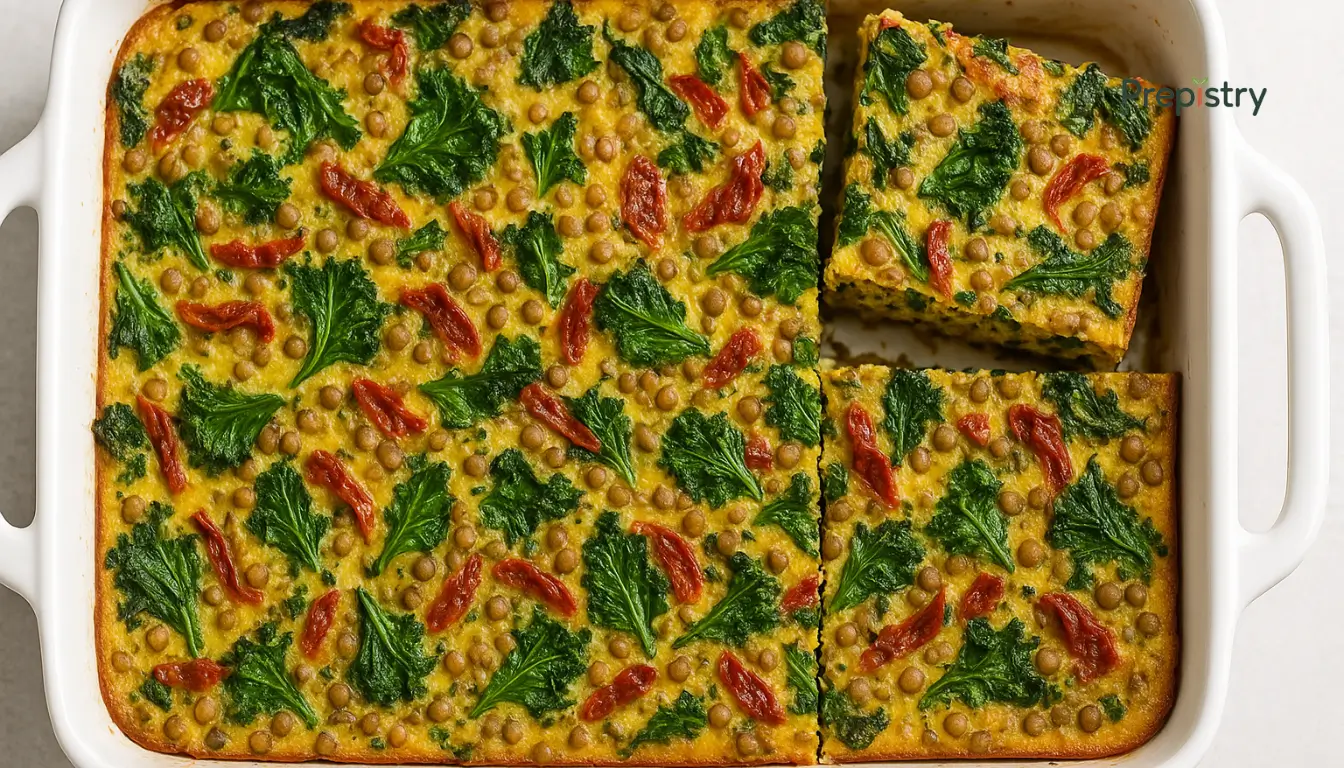
Nutrition Information
Equipment Needed
- 9x13-inch baking dish
- Large mixing bowl
- Medium saucepan
- Whisk
- Oven
Ingredients
-
1 cup cooked lentils
-
1 cup cooked quinoa
-
1 cup chopped kale
-
1/2 cup chopped sun-dried tomatoes
-
1/2 cup diced onion
-
3 large eggs
-
1 cup milk (dairy or plant-based)
-
1/2 cup shredded cheese (optional)
-
1 tsp garlic powder
-
1/2 tsp salt
-
1/4 tsp black pepper
-
2 tbsp olive oil
Instructions
Recipe Video
These quinoa patties are better than meat! Gluten free, easy vegan recipe!
It’s so delicious that I cook it almost every day! The tastiest patties recipe I have ever made!

